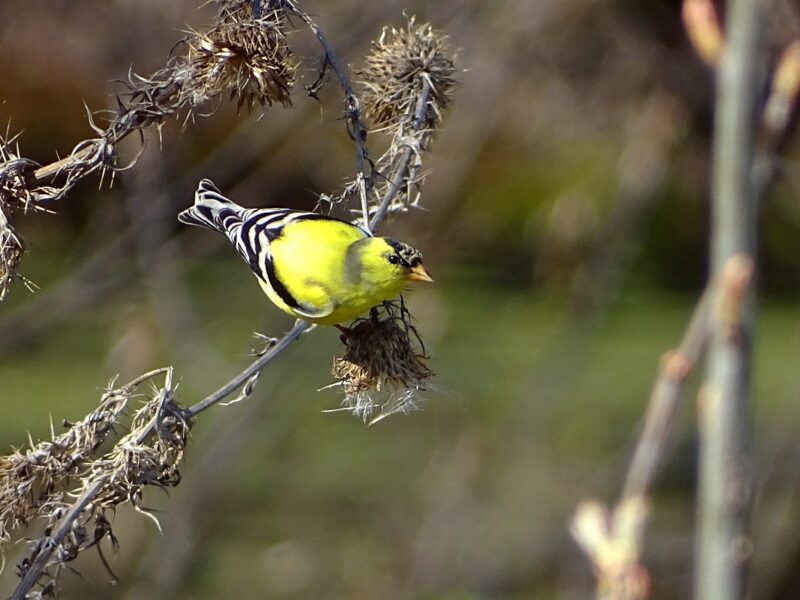
The following essay is by environmental educator Nick Voss, Education & Outreach Coordinator at the Vadnais Lake Area Water Management Organization. Photo by Nick Voss.
The American Goldfinch is a common neighborhood bird, familiar to many as a cheery visitor who’s happy to munch on an offering of birdseed. When paying a visit, they often announce their “po-ta-to-chip” call when flying overhead. But why has the goldfinch taken so kindly to parks and yards, and what does it do when there’s no feeder around? Today we’ll take a closer look at our friendly neighborhood goldfinch, and perhaps glean some insights on why it has such a cheery reputation.
The American Goldfinch has a large nesting range from central Canada to the southern U.S, and winters along the Gulf Coast, into the Southwest, and south into Mexico. In the summer months, goldfinches are one of the latest nesting songbirds. Their patience to wait until late June–early July to lay eggs allows their primary food source — seeds —to be more plentiful and accessible. This reduces flight time for foraging, and saves valuable energy when raising their young.
Yet goldfinches can still be a common sight in a Minnesota winter, as long as they have access to open water, plenty of seeds, and temperatures above zero degrees Fahrenheit. Like the American Robin, goldfinches can act as a local migrant, dipping just south enough into the central US when it’s really needed. To keep warm, goldfinches have been known to burrow in the snow or roost with birds of other species.
A goldfinch’s favorite habitat includes grassy fields, forest edges, and open floodplains. These are spots where dense, shrubby, and seedy vegetation grows in the abundance of sunlight. Alders, birch, asters, coneflowers, and grasses such as big and little bluestem all bear delicious seeds for goldfinches, but their favorite food is often thought to be thistles. Pockets of dense vegetation are valuable for food and shelter, but they also make a home for spiders. While goldfinch don’t eat spiders, they use spider silk to fasten their nests to branches and twigs. Small rootlets, fluffy thistledown, and other plant fibers are woven into goldfinch nests so tight that they’ve been known to temporarily hold water. Gardeners and bird enthusiasts who are looking to not only attract goldfinches with a feeder but also recruit a regular nesting pair would do well to provide a pocket of dense, high-standing vegetation with a shrub or tree nearby.
Goldfinches have been neighbors to gardens and pastures for generations. As our ancestors have watched and observed them, were they just projecting joyful traits onto their sunny feathers? Or are these birds, in whatever sense, actually joyful?
All over the world, small seed-eating finches have accompanied open fields and crops for centuries. I can’t help but wonder if in the days of olde, perhaps one of my own ancestors was a farmer. Perhaps they were having a bad day and noticed a pair of European goldfinches. A farmer in the 18th or 19th century would likely have a keen understanding of the crop and any encroaching “weeds.” Goldfinches would have spent the bulk of their time on these uncultivated plants, particularly thistles and weeds —weeds that could actually be hindering a crop or showing nature’s unforgiving side. Surely to see admiration among finches would require overlooking their stubborn food source. Maybe some farmers chose not to make the leap altogether. How can I really say? Today, thistles are a bane to most any gardener, quickly yanked out and subject to complaints. Chances are even you, the reader, have accidentally brushed up against a thistle in mid-July, cursing at the sting.
Yet the joyful sentiments of the goldfinch have lasted the test of time. Many a mug, quilt, puzzle, and the like are adorned with images of goldfinches perched on pink thistle flowers. Unlike this crusty and defensive plant, goldfinches have carried a sunny disposition for generations. Perhaps it’s that they’re known to not even fight back when preyed upon by cats, hawks, or weasels. Yet there they sing, there they bounce above the trees with a waving flight pattern, chittering on the upswing.
Surely our ancestors from all corners of the world have noticed these contrasts and paradoxes in nature, and perhaps from them, found sparks of inspiration. The ancient landscape was ripe with struggle, but could it also be ripe with joy? When I picture the joy of my ancestors I get a vision of a deep and grounded joy. Seasoned by struggle and hard lessons learned, yet a testament to their resilience and survival and essentially the reason I get to be observing goldfinches today.
Ross Gay provides a wonderfully simple summary of this paradox. In his Book of Delights he writes: “What if we joined our sorrows, I’m saying. I’m saying: What if that is joy?”
Today we know well the sorrow that spans across the landscape; personal tragedies, public health crises, a reckoning with injustices of the past and present, political turmoil, climate change, and all the rest. In such a world, harsh, prickly sentiments can be as abundant as a thistle’s thorns. Perhaps this is when joy is singing out like a goldfinch to be more than surface level. When goldfinch quilts aren’t just cute home decor but a reminder that in the face of absurdity and sorrow, our ancestors also chose joy.
— Nick Voss, nick.voss@vlawmo.org
